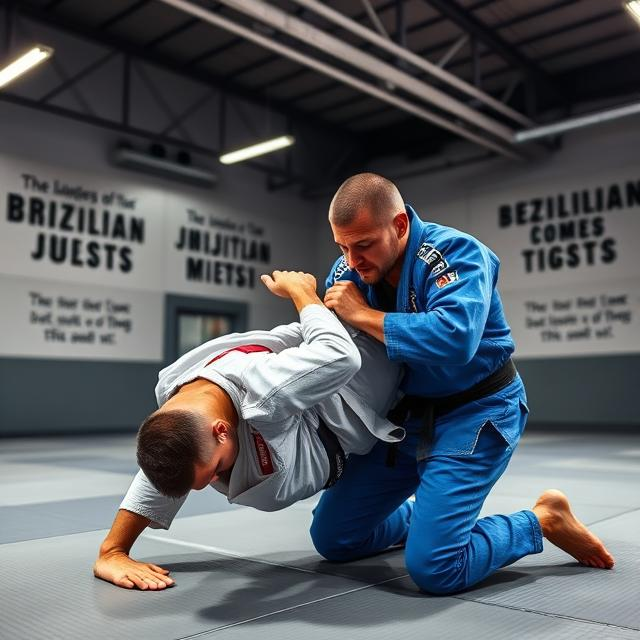If you’ve ever watched a Brazilian Jiu Jitsu match and thought, “Wow, they’re just hugging each other on the ground,” then congratulations, you are not alone. But let me tell you, it’s way more than that. Brazilian Jiu Jitsu (BJJ) is a martial art that turns the idea of strength on its head. It’s not about being the biggest or the toughest. It’s about using technique, leverage, and – if we’re being honest – a fair bit of awkwardness to make your opponent tap out.
So, let’s take a closer look at Brazilian Jiu Jitsu and see why it’s much more than just grappling.
What is Brazilian Jiu Jitsu?
At its core, Brazilian Jiu Jitsu is a martial art that focuses on ground fighting and submissions. It originated from traditional Japanese Jiu Jitsu and Judo but was refined and adapted in Brazil, particularly by the Gracie family. It’s all about using an opponent’s energy against them. You don’t need to be a muscle-bound giant to dominate someone much bigger than you—just ask any BJJ black belt who’s rolled with a 250-pound bodybuilder.
In Brazilian Jiu Jitsu, the goal is to control your opponent, put them in a position where they can’t escape, and force them to give up by tapping out (or verbally crying “uncle,” depending on the situation). There’s a huge focus on submissions like joint locks and chokeholds, which sound scary but are mostly about technique rather than power.
The Magic of Leverage (aka How to Beat Someone Twice Your Size)
One of the main things that makes Brazilian Jiu Jitsu unique is its emphasis on leverage. The idea is simple: instead of trying to out-muscle your opponent, you use angles, body positioning, and a little bit of sneaky trickery to make them feel like they’re trapped in a cage of human limbs.
So, let’s say you’re stuck under someone who looks like they bench press cars for fun. What do you do? You use their size and momentum to your advantage. A small twist here, a well-timed roll there, and suddenly, that bodybuilder is tapping out because you’ve turned their own weight against them. It’s like turning a wrestling match into an episode of Mission Impossible—but with less explosions.
Brazilian Jiu Jitsu for Self-Defense
Many people get into BJJ for self-defense, and for good reason. It teaches you how to defend yourself against larger, stronger opponents in real-life situations. It’s especially useful if you ever find yourself on the ground during a confrontation (and let’s be honest, who doesn’t want to be a ninja on the ground?).
But BJJ isn’t just for protecting yourself; it’s about feeling confident and being able to think on your feet. The more you train, the more comfortable you’ll become bjj close to me your ability to handle different situations, whether you’re defending yourself or just trying to get out of an awkward conversation at a party.
The Belt System: From White to Black (and Beyond!)
Like many martial arts, Brazilian Jiu Jitsu has a belt system that shows your progression. But unlike karate or taekwondo, BJJ belts aren’t handed out like participation trophies at a kids’ birthday party. No, sir. You have to work for it. And not just with brute force—don’t expect to get your black belt after a few months of training. It takes years.
Here’s the general order: white belt (you’re new), blue belt (you’re still figuring things out), purple belt (you’re starting to show off), brown belt (you’re almost there), and black belt (you’re basically a wizard). But don’t get too comfy because after black belt, there are degrees! You can be a black belt with a degree, or two, or even three. It’s like being in a never-ending episode of Jeopardy!, but with more submission holds and less trivia.
Funny Moments in Brazilian Jiu Jitsu
BJJ is not only intense but also full of funny moments. Imagine trying to get someone in a submission and realizing that, instead of choking them out, you’ve just given them a very awkward bear hug. You could be rolling smoothly and suddenly find yourself tangled in a mess of limbs, wondering how you ended up in a position that can only be described as “I-should-have-checked-my-life-choices.”
And then there are those moments when you’re trying to escape a submission, but you accidentally roll into it. You try to act like you meant to do that and hope no one notices. Spoiler alert: they notice.
Brazilian Jiu Jitsu Builds More Than Just Muscle
Okay, let’s not sugarcoat it: BJJ is tough. Your body will ache, your mind will be exhausted, and you’ll probably be sore in places you didn’t even know existed. But as difficult as it is, it builds something far more important than just physical strength—it builds character.
Through consistent training, BJJ teaches you resilience, patience, and humility. It’s easy to think you’re the best when you can submit a few white belts, but wait until you’re caught in a submission by a blue belt or (gasp) a purple belt. That humbling experience is what keeps you grounded and motivated to keep improving.
So, while you might not be able to get out of a headlock in your sleep just yet, after a few months of training, you’ll definitely start to feel more confident, capable, and maybe even a little less clumsy. And hey, that’s a win.
Conclusion: Is Brazilian Jiu Jitsu Worth It?
The short answer: Absolutely. Whether you’re looking to defend yourself, get in shape, or just experience the unique world of Brazilian Jiu Jitsu, it’s worth every moment of struggle. Sure, you’ll probably end up on the floor more often than you’d like (in a good way), and there will be moments when you think, “Why am I doing this?” But in the end, you’ll gain more than just physical skill. You’ll gain confidence, humility, and maybe even a couple of hilarious stories to tell your friends.
So, roll with it, have fun, and just remember: It’s not about being the strongest; it’s about being the trickiest (and maybe throwing in a sneaky submission when no one is looking).





